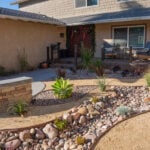Aesthetic Choices Unveiled
Landscape design is a form of art that combines the outdoors’ innate beauty with imaginative human imagination. In this area, two opposing strategies—modern and traditional landscape design—have developed over time. Furthermore, each has a particular ideology, set of guiding ideas, and aesthetic. Understanding the traits of both types will help you select the ideal aesthetic for your outdoor space, whether your goal is to create a tranquil sanctuary or a striking statement.
Essence of Modern Landscape
A sense of wide space, simplicity, and clean lines are the foundations of contemporary landscape design. Additionally, modern architecture frequently combines strong and soft components that influence it in a pleasing way. Therefore, an emphasis on functionality, simplicity, and the incorporation of outdoor living areas distinguishes this design’s aesthetics.
Key Elements :
- Clean Lines and Geometric Shapes: Modern landscapes embrace geometric patterns and straight lines to create a sense of order and simplicity. Rectangular and square shapes are commonly used for hardscape elements, while circular and asymmetrical designs provide contrast and visual interest.
- Minimalist Plantings: Plants in modern landscapes are carefully selected for their architectural qualities. These landscapes often feature a limited color palette and use of grasses, succulents, and low-maintenance plants to maintain the sleek aesthetic.
- Functional Outdoor Spaces: Modern landscape design blurs the lines between indoor and outdoor living. It incorporates outdoor seating areas, kitchens, and entertainment spaces that seamlessly blend with the surrounding environment.
- Use of Hardscape Materials: Hardscape elements like concrete, steel, and glass are fundamental to modern landscapes. They create a sense of structure while emphasizing the juxtaposition between man-made and natural elements.
- Focus on Water and Fire Features: Elements like reflecting pools, fountains, and fire pits provide a tranquil ambiance and therefore, create a soothing atmosphere in modern outdoor spaces.
- Sustainable Practices: Many modern landscapes incorporate sustainable practices, such as drought-tolerant plants, permeable paving, and efficient irrigation systems.
Allure of Traditional Landscape
On the other side, historical aesthetics and classical influence traditional landscape design. It creates a rich and welcoming outdoors. Moreover, it does this setting by using symmetry, lush vegetation, and ornamental embellishments to generate a sense of timelessness.
Key Elements:
- Symmetry and Balance: Traditional landscapes prioritize symmetry and balance in their layouts. The use of axial symmetry often leads the eye to a central focal point. These include fixtures such as a fountain, statue, or entrance.
- Lush Plantings: Abundant plantings are a hallmark of traditional landscapes. Landscapers carefully arrange flowerbeds, shrubs, and trees to create a sense of fullness and harmony.
- Formal Layout: Traditional landscapes often feature a formal layout with defined paths, hedges, and alleys. The design aims to create a sense of order and structure reminiscent of classic European gardens.
- Use of Decorative Elements: Ornate features like trellises, gazebos, and intricate paving patterns contribute to the elegance of traditional landscape design. These elements add a touch of opulence and refinement.
- Natural Materials: To create a cozy and welcoming ambiance natural materials like stone, brick, and wood are used in traditional landscaping.
- Sculptures and Statues: Usually traditional landscapes add sculptures, statues, and other works of art to deliver a sense of history and culture.
Finding Your Aesthetic
When considering whether to embrace a modern or traditional landscape design, several factors come into play:
- Architectural Context: The architectural style of your home can guide your landscape design choices. A modern landscape may complement a modern design. On the contrary, a traditional home might call for a more classic approach.
- Personal Preferences: Your personal style and preferences play a significant role. Do you resonate more with the clean lines and simplicity of modern design, or are you drawn to the lushness and elegance of traditional landscapes?
- Outdoor Functionality: Consider how you intend to use your outdoor space. If you’re looking for functional outdoor living areas, a modern design might offer more flexibility. Moreover, if you’re seeking a tranquil retreat, a traditional design could create a cozy ambiance.
- Maintenance Level: Modern landscapes often require less maintenance due to their minimalist approach. While traditional landscapes with lush plantings might demand more care.
- Local Climate: Your climate will influence plant selection and design elements. Drought-prone regions might lean toward modern landscapes with drought-tolerant plants, while traditional landscapes can thrive in temperate climates.
- Embracing Both Styles: Don’t feel confined to choosing solely between modern and traditional. Many landscapes successfully blend elements of both styles, creating a harmonious fusion that reflects personal taste.
Aesthetics for Unique Charm
Both contemporary and classic landscape designs offer distinctive aesthetics that can accommodate a range of preferences and tastes. Understanding the concepts and components of each design can help you create an outdoor area that reflects your personality and complements your lifestyle. Whether it is the minimalist lines of contemporary or the ageless elegance of traditions it is that you are drawn to. As you begin your adventure into landscape design, keep in mind that your area is a blank canvas for your own self-expression. Hence, this is where imagination and nature come together to create a place of beauty and tranquility.






